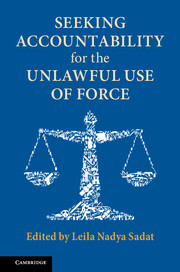Book contents
- Frontmatter
- Dedication
- Contents
- Notes on Contributors
- Foreword
- Preface
- Table of Cases
- Introduction
- PART I HISTORIC AND CONTEMPORARY PERSPECTIVES ON THE UNLAWFUL USE OF FORCE
- 1 The Status of Aggression in International Law from Versailles to Kampala – and What the Future Might Hold
- 2 Nuremberg and Aggressive War
- 3 The Tokyo International Military Tribunal and Crimes Against Peace (Aggression): Is There Anything to Learn?
- 4 The Just War in Ancient Legal Thought
- 5 Definitions of Aggression as Harbingers of International Change
- 6 International Humanitarian Law in an Age of Extremes: Unlawful Uses of Force by Non-State Actors
- PART II MECHANISMS FOR RESTRAINING THE UNLAWFUL USE OF FORCE AND ENHANCING ACCOUNTABILITY
- PART III THE ILLEGAL USE OF FORCE AND THE PROSECUTION OF INTERNATIONAL CRIMES
- PART IV IMAGINING A BETTER WORLD
- Epilogue
- Index
6 - International Humanitarian Law in an Age of Extremes: Unlawful Uses of Force by Non-State Actors
from PART I - HISTORIC AND CONTEMPORARY PERSPECTIVES ON THE UNLAWFUL USE OF FORCE
Published online by Cambridge University Press: 21 May 2018
- Frontmatter
- Dedication
- Contents
- Notes on Contributors
- Foreword
- Preface
- Table of Cases
- Introduction
- PART I HISTORIC AND CONTEMPORARY PERSPECTIVES ON THE UNLAWFUL USE OF FORCE
- 1 The Status of Aggression in International Law from Versailles to Kampala – and What the Future Might Hold
- 2 Nuremberg and Aggressive War
- 3 The Tokyo International Military Tribunal and Crimes Against Peace (Aggression): Is There Anything to Learn?
- 4 The Just War in Ancient Legal Thought
- 5 Definitions of Aggression as Harbingers of International Change
- 6 International Humanitarian Law in an Age of Extremes: Unlawful Uses of Force by Non-State Actors
- PART II MECHANISMS FOR RESTRAINING THE UNLAWFUL USE OF FORCE AND ENHANCING ACCOUNTABILITY
- PART III THE ILLEGAL USE OF FORCE AND THE PROSECUTION OF INTERNATIONAL CRIMES
- PART IV IMAGINING A BETTER WORLD
- Epilogue
- Index
Summary
INTRODUCTION
A good practice carried to an extreme and worked in accordance with the letter of the law becomes a positive evil.
A military historian once remarked that the history of man is the history of war and the history of war is the history of man. History tells us that peace is not the norm despite mankind's efforts to achieve lasting peace. For much of history, conflict has been a barbaric clash of wills with the strong prevailing. In large measure, good rarely triumphed over evil. Though early attempts were made to extend some type of civility to the battlefield, use of law and regulation in protecting combatants is a modern phenomenon. Only in the past fifty years have we seen a comprehensive legal regime evolve that attempts to regulate conduct in conflict.
Despite the establishment of the laws of armed conflict in the past century, modern conflict involves actors who do not follow any international norms and who ignore basic humanitarian principles. The dirty wars of the twentyfirst century will mirror conflict not seen since the Dark Ages. Actors in these conflicts choose to use fear, terror, and suffering as a weapon of war, preying upon the most vulnerable members of society – mainly women and children.
The international community is not prepared to predict, prevent, and fight in these types of conflicts. Even though the development of law in this area has flourished and the jurisprudence from the various international tribunals has developed the ability to hold combatants who do not follow the rule of law on the battlefield accountable, conflict itself has moved backward in many parts of the world where the standard is “no quarter.” Kill or be killed is the new norm in this evolving century.
Along with this devolution in conflict, we see the world in extremes as the final visages of the fifty-year-long Cold War slide away into history. It can be argued that the twentieth century was almost a century-long conflict that historians have broken up into three wars: World War I, World War II, and the Cold War.
- Type
- Chapter
- Information
- Seeking Accountability for the Unlawful Use of Force , pp. 154 - 168Publisher: Cambridge University PressPrint publication year: 2018



